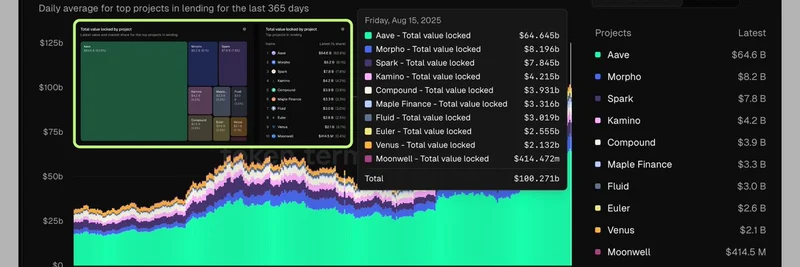DeFi lending is exploding, and if you've been keeping an eye on the crypto space, you'll know that protocols like Aave are at the forefront. A recent thread on X by Satyam Singh (@Satyams2468) breaks down the massive growth in total value locked (TVL) across lending protocols, which has now topped $100 billion. That's a whopping 3.13x increase from $32 billion just a year ago. Aave alone commands $64.6 billion of that, making up 64% of the market. Let's dive into what this means and why lending protocols might just redefine banking as we know it.
The Surge in DeFi Lending
Total deposits into lending protocols have skyrocketed to around $100.2 billion. Aave has seen impressive 3-4x growth in key metrics like TVL, fees, revenue, and active loans over the past year. Singh argues that this is just the beginning—adoption is nascent, and we're nowhere near the potential deposits we could see in the next decade. Think compounding growth as more users and institutions pile in.
What makes lending protocols so appealing? They're essentially decentralized platforms where you can lend or borrow crypto assets without intermediaries. TVL measures the total amount of assets locked in these protocols, indicating trust and usage.
Why Lending Protocols Could Become the World's Largest Banks
Singh outlines several reasons why DeFi lending might eclipse traditional banking:
- Borderless Access: Anyone with internet can participate, no geographic barriers.
- Higher Yields: DeFi offers better returns than the 1-3% from banks.
- Instant Liquidity: Borrow or repay 24/7 in minutes, no paperwork.
- Diverse Collateral: Use crypto, NFTs, tokenized stocks, or even precious metals.
- Global Rate Arbitrage: Borrow low, lend high across borders.
- Inclusive Participation: From hedge funds to governments, everyone can join.
Imagine using your Apple stock as collateral to borrow on Aave at 5% interest, or lending stablecoins like USDT for higher yields elsewhere. This flexibility is a game-changer.
Tokenization and Real-World Assets
A key point in the thread is tokenization—turning real-world assets like stocks into blockchain tokens. This could make U.S. equities accessible globally without KYC, high fees, or sanctions restrictions. For instance, buying Apple stock traditionally involves brokers, currency conversions (0.5-2% fees), and tax forms. On-chain, it's seamless and cheap.
In high-interest countries with stagnant markets, people could invest in top performers like U.S. stocks and borrow against them at fair rates (4-6% on Aave). Singh predicts that if just 10% of the $23 trillion market cap of top U.S. stocks comes on-chain in five years, that's $2.3 trillion. Even 10% of that in Aave could add $230 billion to its TVL—without accounting for stock growth, which could double in that time.
By 2030, he sees Aave hitting $500-700 billion in TVL. That's ambitious but grounded in the shift toward tokenized assets.
Community Reactions and Other Protocols
The thread sparked reactions, with users like @YashasEdu calling Aave "the bank in crypto," and @Bit_Maddy highlighting protocols like Fluid and Euler as strong contenders. Token Terminal (@tokenterminal) praised the write-up too. It's clear the community sees huge potential here.
In the meme token world, this matters because many memes rely on DeFi for liquidity and yield farming. As lending grows, it could provide more stable borrowing options for meme projects or holders looking to leverage without selling.
Looking Ahead
DeFi lending isn't just a niche—it's evolving into a global financial powerhouse. With Aave leading the charge, the barriers of traditional finance are crumbling. If you're in blockchain, keep an eye on these protocols; they could unlock new ways to grow your portfolio. For more insights on how DeFi intersects with meme tokens and crypto trends, stick around at Meme Insider.



